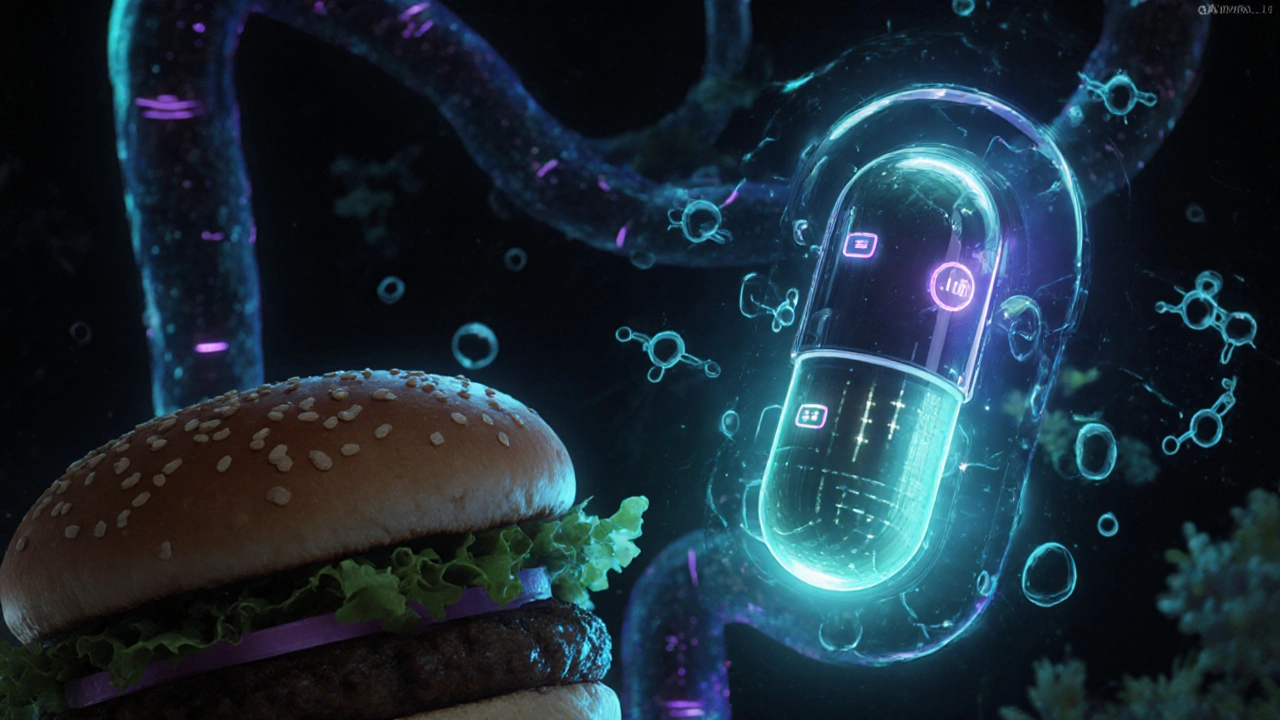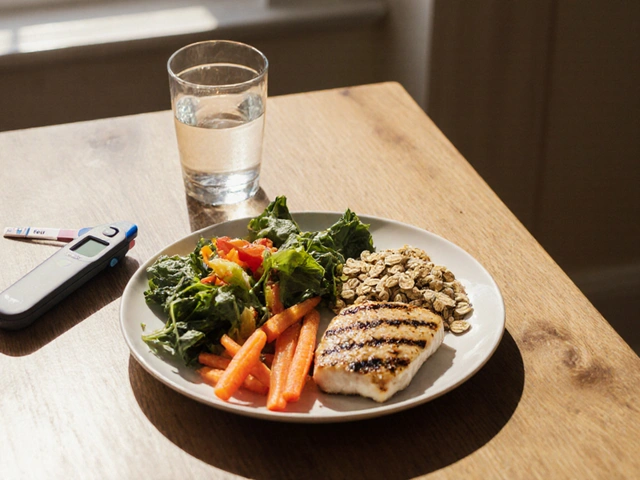
Lipid Medication Absorption Calculator
How does the fat in your meal affect your medication? Enter your medication and meal type to see estimated absorption rates based on clinical studies.
Select medication and meal type to see results
When you take a pill with a glass of water, you might assume it’s just going straight to work. But for many medications-especially those designed to treat chronic conditions like high cholesterol, organ transplant rejection, or fungal infections-what you eat with that pill matters just as much as the pill itself. Fatty foods aren’t just calories; they’re active participants in how your body absorbs certain drugs. This isn’t magic. It’s science. And it’s changing how thousands of people manage their health every day.
Why Fat Helps Some Drugs Work Better
Not all medications behave the same in your gut. About 70% of new drugs being developed today are poorly soluble in water. That means they don’t dissolve easily, and if they don’t dissolve, your body can’t absorb them. These are the drugs that end up in the Biopharmaceutics Classification System (BCS) as Class II or IV-low solubility, high or low permeability. For these, fat isn’t optional. It’s essential. When you eat a meal with fat, your body responds. Bile gets released from your gallbladder. Lipase enzymes break down triglycerides into fatty acids and monoglycerides. These breakdown products team up with bile salts to form tiny structures called mixed micelles. Think of them like microscopic oil trucks that pick up drug molecules and carry them through the thick mucus lining of your intestine. Without fat, these trucks don’t show up. The drug just sits there, useless. Studies show lipid-based formulations can boost absorption by 20% to over 300% compared to regular tablets. Cyclosporine, used after organ transplants, is one of the clearest examples. The original version, Sandimmune®, needed to be taken with a high-fat meal to work properly. The newer lipid-based version, Neoral®, changed that. Patients no longer had to time meals around doses. Bioavailability went up by 20-30%. That’s not a small win-it’s the difference between rejection and survival.How Lipid-Based Formulations Are Built
Pharmaceutical companies don’t just add oil to pills. They engineer precise mixtures called lipid-based drug delivery systems. The most common type is the self-emulsifying drug delivery system, or SEDDS. These are liquids packed into soft gel capsules. Inside, you’ll find three key ingredients:- Oil phase (30-60%): Usually medium-chain triglycerides (MCTs) from coconut or palm oil. MCTs digest faster than long-chain fats, making them ideal for quick drug release.
- Surfactants (20-50%): Things like Tween 80 or Cremophor EL. These help the oil mix with water in your gut, forming tiny droplets under 300 nanometers.
- Cosolvents (10-30%): Like Transcutol HP. They keep the drug dissolved before it even hits your stomach.
The Food Effect: What Happens When You Skip the Fat
The term “food effect” isn’t just a buzzword. It’s a well-documented phenomenon in pharmacokinetics. For some drugs, taking them without fat means you get barely half the dose you think you’re getting. Take itraconazole again. The capsule form needs a fatty meal to reach effective blood levels. If you take it with tea and toast, absorption drops by up to 40%. That’s dangerous for someone fighting a fungal infection. The lipid-based oral solution eliminates this problem. It doesn’t care if you ate a donut or nothing at all. But here’s the catch: not all drugs benefit from fat. Drugs like bisphosphonates (used for osteoporosis) need an acidic stomach environment to dissolve. Fat slows gastric emptying, which raises pH and reduces absorption. Taking these with food can make them useless. And then there’s variability. People digest fat differently. Someone with Crohn’s disease, gallbladder removal, or pancreatic insufficiency may not produce enough bile or lipase. For them, even lipid-based drugs might not work as expected. That’s why experts like Dr. Gordon Amidon warn that food effects aren’t one-size-fits-all.
Why Lipid-Based Isn’t Always the Best Choice
Lipid-based formulations are powerful-but they’re not perfect. They’re more expensive. Producing them adds 25-35% to manufacturing costs. That’s why generic versions of older drugs are still sold as plain tablets. Sporanox® oral solution costs around $1,200 for a 30-day supply. The generic capsule? About $300. For many patients, that’s a dealbreaker. They’re also trickier to store. Soft gel capsules are sensitive to heat and moisture. They need special packaging. Regular tablets? You can leave them in a medicine cabinet for years. Lipid formulations often need refrigeration or desiccant packs. And while they help with solubility, they don’t fix everything. If a drug’s solubility is below 1 microgram per milliliter-even the best lipid system might only get you 20% absorption. That’s why companies are now experimenting with enzyme-triggered release systems. Matinas BioPharma’s LNC platform, for example, boosted amphotericin B bioavailability to 92% in trials, compared to just 30% with old formulations.What Patients Are Saying
Real-world feedback tells a clear story. On Reddit’s r/pharmacy community, users report major improvements after switching to lipid-based versions. One transplant patient wrote: “Switching to Neoral eliminated my need to plan meals around my meds. I can eat when I want now.” Another said: “Tricor doesn’t give me the stomach upset I had with Lopid. I take it once a day instead of three times. Life’s easier.” But cost remains a pain point. “I’d love the lipid version,” wrote one user, “but my insurance won’t cover it. I’m stuck with the cheap one and still get heartburn.” Clinically, the data backs this up. A 2022 study on fenofibrate found 87% of patients reported fewer stomach issues with Tricor®. Seventy-two percent preferred it-mostly because they didn’t have to take it three times a day.
What’s Next for Lipid-Based Medications
The future is personal. Researchers at MIT recently published a prototype “smart lipid capsule” in Science Advances. It doesn’t just release drug-it monitors your gut pH and enzyme levels in real time and adjusts release accordingly. Imagine a pill that knows you just ate a burger and says, “Okay, now’s the time to release the drug.” Regulators are paying attention too. The FDA and EMA now require detailed food effect studies for new lipid-based drugs. That means more transparency, better labeling, and fewer surprises for patients. The market is growing fast. In 2022, lipid-based delivery systems made up $5.8 billion of the global drug market. By 2028, that’s expected to hit $9.2 billion. Oncology, immunology, and antiviral drugs are leading the charge because so many of their compounds are poorly soluble. And sustainability is becoming a concern. Some lipid ingredients still come from fish oil. The European Federation for Pharmaceutical Sciences is pushing for plant-based alternatives. That’s the next frontier: better performance without harming the planet.What You Should Do
If you’re on a medication that’s known to have a food effect, don’t guess. Check the label. Ask your pharmacist. Some drugs say “take with food.” Others say “take on an empty stomach.” That’s not random. It’s science. Don’t assume all fats are equal. Medium-chain triglycerides (MCTs) are the gold standard in formulations, but in your diet, it doesn’t matter as much. A spoonful of peanut butter, a few olives, or a slice of cheese can be enough to trigger the right response. You don’t need a full fry-up. If cost is an issue, ask about generics. Sometimes the lipid version is the only option. Other times, a generic tablet taken with a small amount of fat works just fine. And if you have a digestive condition-IBS, Crohn’s, gallbladder removal-talk to your doctor. Your ability to digest fat affects how well your meds work. You might need a different formulation. Lipid-based medications aren’t a cure-all. But for the right drug, in the right person, they turn a barely effective pill into a life-changing treatment. Fat isn’t the enemy. Sometimes, it’s the missing piece.Do all fatty foods help with drug absorption?
No. While dietary fat triggers the body’s natural absorption mechanisms, not all fats work the same. Medium-chain triglycerides (MCTs), found in coconut oil and some supplements, digest faster and are more effective than long-chain fats like those in butter or red meat. But for most patients, even a small amount of fat-like a tablespoon of peanut butter or a few avocado slices-is enough to help lipid-based medications absorb properly. The key is consistency, not quantity.
Can I take lipid-based medications without food?
It depends on the formulation. Older versions of drugs like itraconazole or cyclosporine required food to work. But modern lipid-based formulations-like Sporanox® oral solution or Neoral®-are designed to work regardless of food intake. Always check the prescribing information. If the label says “take with or without food,” you’re safe either way. If it says “take with a high-fat meal,” skip the fasting.
Why are lipid-based medications more expensive?
They’re more complex to make. Instead of simple powder in a tablet, they require precise blends of oils, surfactants, and solvents, all stabilized in soft gel capsules. Manufacturing requires specialized equipment, strict temperature control, and extensive testing. Production costs are 25-35% higher than regular tablets. That’s why generics often remain cheaper-even if the lipid version works better.
Do lipid-based drugs work for everyone?
Not always. People with conditions that affect fat digestion-like cystic fibrosis, gallbladder removal, pancreatitis, or Crohn’s disease-may not produce enough bile or lipase. Without these, even lipid-based formulations can underperform. If you have a digestive disorder and your medication doesn’t seem to be working, talk to your doctor. You might need a different formulation or a supplement like bile salts.
Are there any side effects from taking fat with medication?
The fat itself usually doesn’t cause side effects. But some lipid-based drugs can cause mild gastrointestinal discomfort, like nausea or loose stools-especially at higher doses. This isn’t because of the fat, but because of the drug’s action. For example, fenofibrate in lipid form causes less stomach upset than older versions, which is why many patients prefer it. If you have persistent symptoms, don’t assume it’s the food. Talk to your pharmacist or doctor.
Write a comment
Your email address will not be published.






1 Comments
Been taking my cyclosporine with peanut butter for years. No more stomach issues. Just a spoonful. Works better than the fancy pills my doc tried to push.